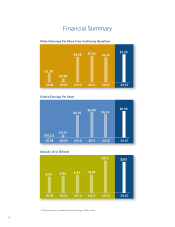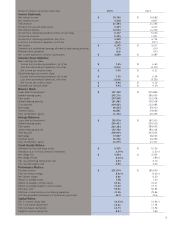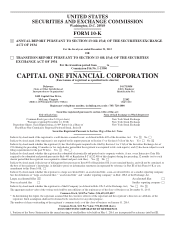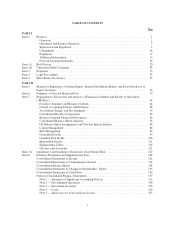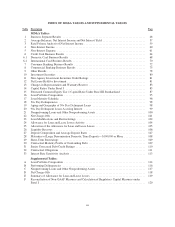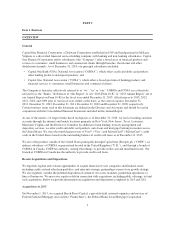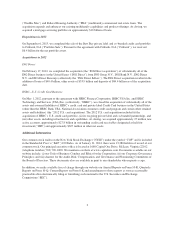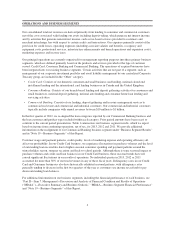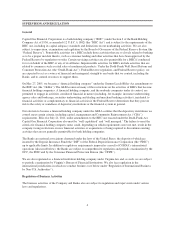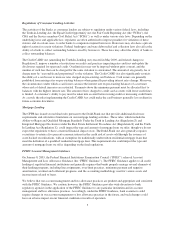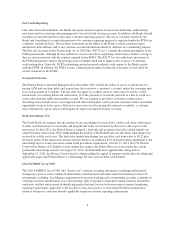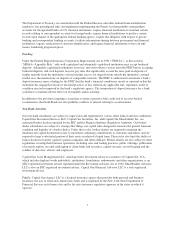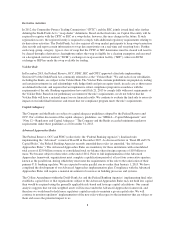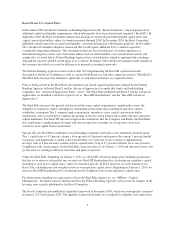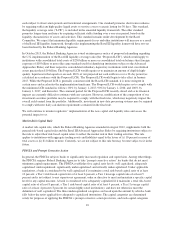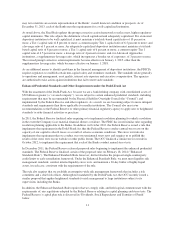Capital One 2013 Annual Report Download - page 23
Download and view the complete annual report
Please find page 23 of the 2013 Capital One annual report below. You can navigate through the pages in the report by either clicking on the pages listed below, or by using the keyword search tool below to find specific information within the annual report.
OPERATIONS AND BUSINESS SEGMENTS
Our consolidated total net revenues are derived primarily from lending to consumer and commercial customers
net of the costs associated with funding our assets including deposit-taking, which generate net interest income,
and by activities that generate non-interest income, such as fee-based services provided to customers and
merchant interchange fees with respect to certain credit card transactions. Our expenses primarily consist of the
provision for credit losses, operating expenses (including associate salaries and benefits, occupancy and
equipment costs, professional services, infrastructure enhancements and branch operations and expansion costs),
marketing expenses and income taxes.
Our principal operations are currently organized for management reporting purposes into three primary business
segments, which are defined primarily based on the products and services provided or the type of customer
served: Credit Card, Consumer Banking and Commercial Banking. The operations of acquired businesses have
been integrated into our existing business segments. Certain activities that are not part of a segment, such as
management of our corporate investment portfolio and asset/ liability management by our centralized Corporate
Treasury group, are included in the “Other” category.
•Credit Card: Consists of our domestic consumer and small business card lending, national closed end
installment lending and the international card lending businesses in Canada and the United Kingdom.
•Consumer Banking: Consists of our branch-based lending and deposit gathering activities for consumers and
small businesses, national deposit gathering, national auto lending and consumer home loan lending and
servicing activities.
•Commercial Banking: Consists of our lending, deposit gathering and treasury management services to
commercial real estate and commercial and industrial customers. Our commercial and industrial customers
typically include companies with annual revenues between $10 million to $1 billion.
In the first quarter of 2012, we re-aligned the loan categories reported by our Commercial Banking business and
the loan customer and product types included within each category. Prior period amounts have been recast to
conform to the current period presentation. Table 1 summarizes our business segment results, which we report
based on income from continuing operations, net of tax, for 2013, 2012 and 2011. We provide additional
information on the realignment of our Commercial Banking business segment under “Business Segment Results”
and in “Note 19—Business Segments” of this Report.
Customer usage and payment patterns, credit quality, levels of marketing expense and operating efficiency all
affect our profitability. In our Credit Card business, we experience fluctuations in purchase volumes and the level
of outstanding loan receivables due to higher seasonal consumer spending and payment patterns around the
winter holiday season, summer vacations and back-to-school periods. Although there is some seasonal impact to
purchase volumes and credit card loan balances in our Credit Card business, these seasonal trends have not
caused significant fluctuations in our results of operations. No individual quarter in 2013, 2012 or 2011
accounted for more than 30% of our total revenues in any of these fiscal years. Delinquency rates in our Credit
Card and Consumer businesses also have historically exhibited seasonal patterns, with delinquency rates
generally tending to decrease in the first two quarters of the year as customers use income tax refunds to pay
down outstanding loan balances.
For additional information on our business segments, including the financial performance of each business, see
“Part II—Item 7. Management’s Discussion and Analysis of Financial Condition and Results of Operations
(“MD&A”)—Executive Summary and Business Outlook,” “MD&A—Business Segment Financial Performance”
and “Note 19—Business Segments” of this Report.
3



